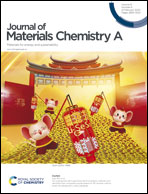Thermoelectric properties of Cu4Ge3Se5 with an intrinsic disordered zinc blende structure†
Abstract
The development of novel thermoelectrics has largely relied on the discovery of materials with a low lattice thermal conductivity. Disordered point defects have been demonstrated to be effective in reducing the lattice thermal conductivity through the resultant strong phonon scattering. In this work, ternary zinc blende Cu4−δGe3Se5, intrinsically coming with a high degree of intrinsic atomic disorder, is focused on, with an expectation of a low intrinsic lattice thermal conductivity for potential thermoelectric applications. The so-called Cu4Ge3Se5 compound is found to be stabilized at a Cu-deficient composition of around Cu3.5Ge3Se5 and the lattice thermal conductivity (κL) is revealed to be only 0.6 W m−1 K−1 at 750 K, which is about one order of magnitude lower than that of ordered binary zinc blende compounds (including group III–V and IIB–VI compounds). This ensures a peak zT of 0.5 to be achieved at 750 K, which is competitive to that of single-crystal InSb. In addition, a single parabolic band (SPB) model with acoustic phonon scattering provides a reasonable understanding of the electronic transport properties. This work illustrates the strategy of intrinsic atomic disorder for novel thermoelectrics with a low lattice thermal conductivity.



 Please wait while we load your content...
Please wait while we load your content...